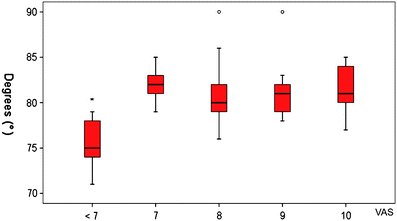Perception of improvement after orthognathic surgery: the important variables affecting patient satisfaction
- PMID: 20306101
- PMCID: PMC2928919
- DOI: 10.1007/s10006-010-0212-2
Perception of improvement after orthognathic surgery: the important variables affecting patient satisfaction
Abstract
Purpose: We evaluated which factors affect patient satisfaction and if patient expectations were fulfilled after orthognathic surgery.
Methods: Questionnaires consisting of 14 questions were given 1 year after bimaxillary osteotomy for class-III correction to subjects. Six questions were answered using an 11-point rating scale based on a visual analog scale (VAS; 0 = poor; 10 = excellent). Also included were seven closed-form questions with yes/no answers, as well as one open question for 'further remarks'. Sagittal and vertical cephalometric parameters were determined on postoperative cephalograms.
Results: Seventy-seven patients (37 females, 40 males; mean age, 23.4 +/- 4.9 (SD) years) responded. The intention to undergo surgery only for aesthetic improvement was noted in 11.9% of patients; only improvement of chewing function in 15.5%; both in 71.4%; and none/don't know in 2.6%. Postoperative satisfaction was rated (in means) with 8.13 +/- 1.97 on VAS and correlated significantly with the opinions of friends and relatives. Facial aesthetics was rated 5.6 +/- 1.2 before surgery and 8.1 +/- 1.5 after surgery (p = 0.04). Preoperative chewing function was rated 5.65 +/- 1.8 and 8.03 +/- 1.51 after surgery (p = 0.014). TMJ disorders or hypoesthesia had no negative impacts. Cephalometric analyses revealed a significantly lower SNB (75.3 degrees +/- 2.7 degrees ; p = 0.033) in patients rating lower than grade 7 for overall satisfaction. For SNA and ArGoMe, no significant differences were observed.
Conclusion: The most distinctive factors for patient satisfaction after orthognathic surgery were chewing function and facial aesthetics with respect to the lower face. Function, aesthetics, and even psychological aspects should be considered equally when planning surgery.
Figures




References
-
- Barbosa AL, Marcantonio E, Barbosa CE, Gabrielli MF, Gabrielli MA. Psychological evaluation of patients scheduled for orthognathic surgery. J Nihon Univ Sch Dent. 1993;35:1–9. - PubMed
Publication types
MeSH terms
LinkOut - more resources
Full Text Sources
Research Materials

